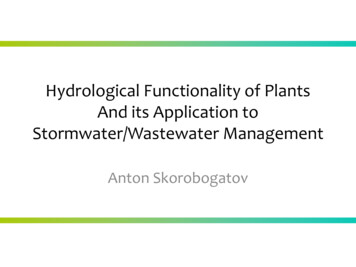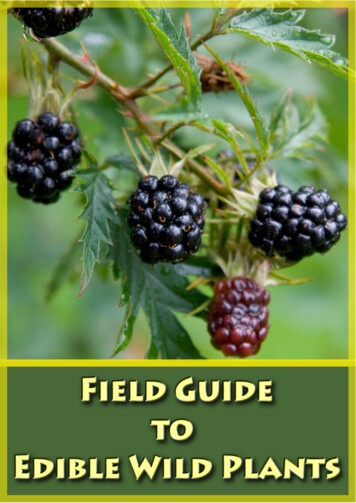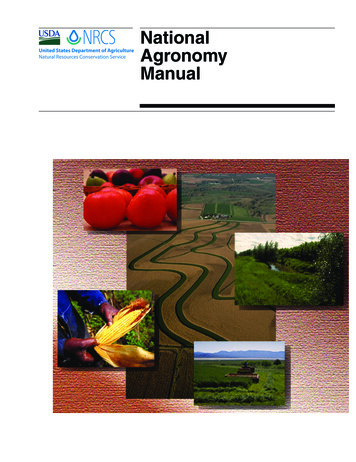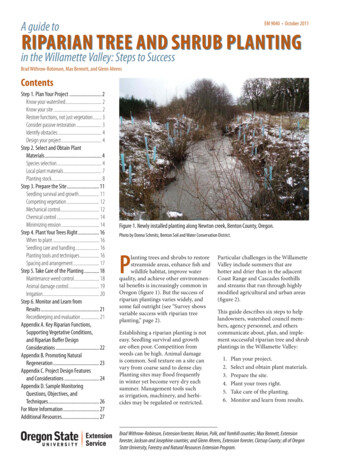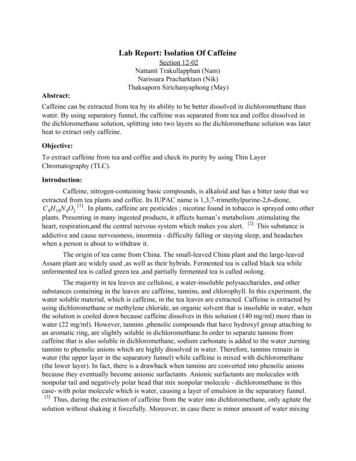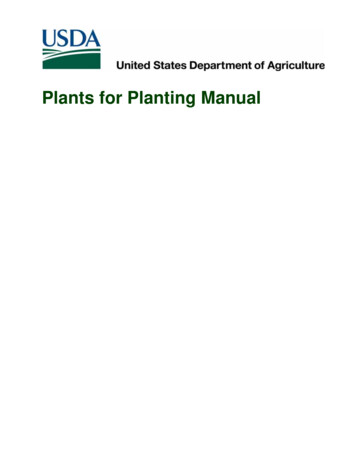
Transcription
Plants for Planting Manual
The U.S. Department of Agriculture (USDA) prohibits discrimination in all its programs and activities on thebasis of race, color, national origin, age, disability, and where applicable, sex, marital status, familial status,parental status, religion, sexual orientation, genetic information, political beliefs, reprisal, or because all orpart of any individual’s income is derived from any public assistance program. (Not all prohibited basesapply to all programs). Persons with disabilities who require alternative means for communciation ofprogram information (Braille, large print, audiotape, etc.) should contact USDA’s TARGET Center at (202)720-2600 (voice and TDD). To file a complaint of discrimination, write to USDA, Director, Office of CivilRights, 1400 Independence Avenue, SW., Washington, DC 20250-9410, or call (800) 795-3272 (voice) or(202) 720-6382 (TDD). USDA is an equal opportunity provider and employer.The opinions expressed by individuals in this report do not necessarily represent the policies of the U.S.Department of Agriculture.First Edition March 2017
ContentsPlants on1-1General Restrictions2-1Plants for Planting ImportsSpecific Restrictions3-1Plants for Planting ImportsPlants for Planting from Canada4-1Postentry Quarantine5-1Plants for PlantingLists of Plants for Planting 6-1Specific Import Requirements and RestrictionsPlants in Growing Media Programs7-1Preclearance Programs8-1Bulbs and Underground Portions of Dormant PerennialsProtected Plants9-1CITES and ESAOffshore Greenhouse Certification ProgramPlant Inspection StationsPorts of Entry10-1A-1Regulatory ActionB-1Emergency Measures, Federal Orders, Federal Register Notices andRules03/2022-84Plants for Planting ManualTOC-1
FormsGlossaryIndexTOC-2C-1Glossary-1Index-1Plants for Planting Manual03/2022-84
FiguresPlants forPlantingManualFigure 2-1Figure 2-2Figure 8-1Figure 8-2Figure 8-3Figure 8-4Figure 9-1Figure 9-2Figure C-1Figure C-2Figure C-3Figure C-404/2022-86Orchid Growing On (not in) a Tree Fern Slab(Photo by Martin Gutierrez, APHIS) 2-7Orchid Growing In (not on) Coconut Fiber (not acceptable) 28Example of Preclearance Statement on Invoice 8-5Example of Copy-Certificate of Examination fromNetherlands 8-5Example of Label on Mail Order Shipment “Pre-cleared FlowerBulbs” as per Phytosanitary Certificate (with Phytosanitary Certificate Number in Top Right) 8-6Example of Label “Flower Bulbs from Holland” on Mail OrderShipment 8-6CITES Appendices I, II and III Interpretation Valid from November 26, 2019 (page 1) 9-4CITES Appendices I, II and III Interpretation Valid from November 26, 2019 (page 2) 9-5Example of Canadian Nursery Certification Program Phytosanitary Certificate(Official CFIA/ACIA 5378, Canadian Nursery Certification Program (CNCP Export Label Document) with CFIA/ACIA 5425,Phytosanitary Certificate (CNCP Phytosanitary Certificate Label) affixed) C-2CFIA/ACIA 5378, Canadian Nursery Certification Program(CNCP export label document) (Blank) C-4Example of CFIA/ACIA 5425, Phytosanitary Certificate (CNCPPhytosanitary Certificate Label) (Redacted) C-6Example of Foreign Site Certificate of Inspection and/orTreatment C-8Plants for Planting ManualLOF-1
FiguresLOF-2Plants for Planting Manual04/2022-86
TablesPlants forPlantingManualTable 1-1Table 1-2Table 1-3Table 1-4Table 2-1Table 2-2Table 2-3Table 2-4Table 3-1Table 3-2Table 3-3Table 3-4Table 3-5Table 3-6Table 3-7Table 3-8Table 3-9Table 3-10Table 3-11Table 3-12Table 3-13Table 3-1404/2022-867 CFR Foreign Plant Quarantines Effective April 18, 2018 1-8Other Regulations 1-9How to Use Decision Tables 1-11Where to Report Problems, Disagreements,Improvements 1-14Size and Age Restrictions for Whole (Entire) Plants 2-9Size Restrictions for Plant Parts Imported as Plants forPlanting 2-12USDA-APHIS Approved Packing Material 2-22Approved CBP Ports of Entry and Designated USDA PlantInspection Stations 2-25Consolidation of 319 Subparts for Plants for Planting to 7 CFR319.37-1 through 319.37-23 3-10Plant Material Requiring Treatment for Entry 3-18Host Plants (except seeds) of Anoplophora chinensis (CLB)and/or Anoplophora glabripennis (ALB) 3-27Host Plants (except seeds) of Anoplophora chinensis (CLB) orAnoplophora glabripennis (ALB) from Canada 3-37Host Plants (except seeds) of Anoplophora chinensis (CLB) orAnoplophora glabripennis (ALB) Exported from Canada With aThird Country of Origin 3-38Host Plants (except seeds) of Anoplophora chinensis (CLB)and/or Anoplophora glabripennis (ALB) Imported into Canadafrom a Third Country 3-39Host Plants (except seeds) of Anoplophora chinensis (CLB) orAnoplophora glabripennis (ALB) from All Countries Other thanCanada Where ALB and/or CLB Is Present 3-40Host Plants (except seeds) of ALB and CLB from CountriesOther than Canada Where ALB and CLB Are Not Present 341Host Plants (except seeds) of Phytophthora kernoviae 3-45List of Host Plants (except seeds) of Phytophthora ramorum(sudden oak death) 3-52Host Plants (except seeds) of Phytophthora ramorum Exportedfrom Canada 3-54Host Plants (except seeds) of Phytophthora ramorum fromOther than Canada 3-55Plants from Potato Cyst Nematode (PCN) InfestedCountries 3-57Rutaceae Family Seeds 3-66Plants for Planting ManualLOT-1
TablesTable 3-15Table 3-16Table 3-17Table 3-18Table 3-19Table 3-20Table 3-21Table 3-22Table 4-1Table 4-2Table 5-1Table 5-2Table 6-1Table 6-2Table 6-3Table 6-4Table 6-5Table 6-6Table 6-7Table 6-8Table 6-9Table 6-10Table 6-11Table 6-12Table 6-13Table 6-14LOT-2Regulating Berberis spp. Plants for Planting 3-77List of Designated Black Stem Rust Resistant Berberis(Mahoberberis, Mahonia) Species and Varieties (from 7 CFR301.38) 3-78Size and Age Restrictions for Dracaena spp. Entire (Whole)Plants Imported as Plants for Planting from Costa Rica 3-107Mangifera spp. Plants for Planting 3-137Poncirus spp. Seeds of Rutaceae Family 3-152Prunus spp. Plants (except Seeds) 3-163Prunus spp. Seeds Not Susceptible to Plum Pox (Sharka)Potyvirus 3-167Prunus spp. Seeds Only 3-168How to Handle U.S.-Canada Greenhouse Certification ProgramShipments During TransitionPeriod (prior to December 18, 2021) 4-14Handling U.S.-Canada Nursery Certification ProgramShipments 4-27List of States With Postentry Quarantine Agreements 5-5List of Restricted Postentry Quarantine Plants for Planting(except seeds) 5-14Key to Lists of Regulated Plants for Planting With SpecificRestrictions 6-5“A” List of Regulated Plants for Planting With SpecificRestrictions 6-7“B” List of Regulated Plants for Planting With SpecificRestrictions 6-91“C” List of Regulated Plants for Planting With SpecificRestrictions 6-334“D” List of Regulated Plants for Planting With SpecificRestrictions 6-431“E” List of Regulated Plants for Planting With SpecificRestrictions 6-464“F” List of Regulated Plants for Planting With SpecificRestrictions 6-499“G” List of Regulated Plants for Planting With SpecificRestrictions 6-517“H” List of Regulated Plants for Planting With SpecificRestrictions 6-534“I” List of Regulated Plants for Planting With SpecificRestrictions 6-565“J” List of Regulated Plants for Planting With SpecificRestrictions 6-577“K” List of Regulated Plants for Planting With SpecificRestrictions 6-580“L” List of Regulated Plants for Planting With SpecificRestrictions 6-586“M” List of Regulated Plants for Planting With SpecificRestrictions 6-626Plants for Planting Manual04/2022-86
TablesTable 6-15Table 6-16Table 6-17Table 6-18Table 6-19Table 6-20Table 6-21Table 6-22Table 6-23Table 6-24Table 6-25Table 6-26Table 6-27Table 7-1Table 7-2Table 8-1Table 8-2Table 9-1Table 9-2Table A-104/2022-86“N” List of Regulated Plants for Planting With SpecificRestrictions 6-691“O” List of Regulated Plants for Planting With SpecificRestrictions 6-711“P” List of Regulated Plants for Planting With SpecificRestrictions 6-731“Q” List of Regulated Plants for Planting With SpecificRestrictions 6-825“R” List of Regulated Plants for Planting With SpecificRestrictions 6-837“S” List of Regulated Plants for Planting With SpecificRestrictions 6-866“T” List of Regulated Plants for Planting With SpecificRestrictions 6-926“U” List of Regulated Plants for Planting With SpecificRestrictions 6-971“V” List of Regulated Plants for Planting With SpecificRestrictions 6-974“W” List of Regulated Plants for Planting With SpecificRestrictions 6-993“X” List of Regulated Plants for Planting With SpecificRestrictions 6-997“Y” List of Regulated Plants for Planting With SpecificRestrictions 6-998“Z” List of Regulated Plants for Planting With SpecificRestrictions 6-999Approved Growing Media List for Plants in Approved GrowingMedia Program (except Hyacinthus spp.) 7-3Status of Approved Plant Taxa for a Plants in Growing MediaProgram 7-4Key to Abbreviations for List of Dormant Bulbs andUnderground Portions of Dormant Perennials 8-10List of Bulbs (B) and Underground Portions of DormantPerennials (DP) That Are Eligible for Preclearance in an APHISApproved Program 8-11CITES Annotations to the Appendices as of November 26,2019 9-6Footnotes to CITES Annotations (Plants Only) as of November26, 2019 9-7List of Ports of Entry and USDA Plant Inspection StationsA2Plants for Planting ManualLOT-3
TablesLOT-4Plants for Planting Manual04/2022-86
Chapter1IntroductionContentsPurpose 1-2Scope 1-3What the Manual Covers 1-3What the Manual Does Not Cover 1-5Users 1-6Related Documents 1-7Authority 1-7Other Documents 1-9Application 1-9Conventions 1-10Advisories 1-10Boldface 1-11Change Bars 1-11Contents 1-11Control Data 1-11Decision Tables 1-11Examples 1-12Footnotes 1-12Heading Levels 1-12Hyperlinks to Figures, Headings, and Tables 1-13Italics 1-13Numbering Scheme 1-13Transmittal Numbers 1-13Using the Plants for Planting Manual 1-14Reporting Problems with or Suggestions for the ManualManual Updates 1-141-1412/2020-62Plants for Planting Manual1-141-1
IntroductionPurposePurposeThe Plants for Planting Manual provides the background, procedures, andreference tables for regulating imported material of plants and vegetative partsthat are for or capable of propagation, including buds, bulbs, corms, cuttings,layers, pollen, scions, seeds, tissue, tubers, and like structures.The plants and vegetative parts from the countries of origin listed in thismanual are regulated because just one destructive pest might be enough to starta pest outbreak that can cause millions of dollars in damage to crops, trees,flowers, or lawns. By their destructiveness, pests can increase the price andreduce the quality of food, lower property values, and ruin recreational areas.The extinction of just one plant species does away with the aesthetic,ecological, educational, historical, recreational, commercial, and scientificvalue of our world.1-2Plants for Planting Manual12/2020-62
IntroductionScopeScopeWhat the Manual CoversThe Plants for Planting Manual covers all imported regulated plants and plantparts that are for or capable of propagation, including buds, bulbs, corms,cuttings, layers, pollen, scions, seeds, tissue, tubers, and like structures.The manual is divided into the following chapters: Introduction General Restrictions Specific Restrictions Plants for Planting from Canada Postentry Quarantine Lists of Plants for Planting Plants in Growing Media Programs Preclearance Programs Protected PlantsThe manual includes the following appendixes: Plant Inspection Stations Regulatory Action FormsThe manual includes a Glossary.The Introduction provides basic information about the Plants for PlantingManual. This chapter includes the manual’s purpose, scope, users, andapplication; a list of related documents that provide the authority for themanual’s content; directions for using the manual; conventions (unfamiliar orunique symbols and highlighting) that appear throughout the manual; andcontact information for problems with or suggestions for the manual.The General Restrictions chapter provides the general requirements forimporting plants for planting into the United States.The Specific Restrictions chapter provides the specific requirements andrestrictions for individual plants for planting taxa. Specific Restrictions are inaddition to General Restrictions.12/2020-62Plants for Planting Manual1-3
IntroductionScopeThe Plants for Planting from Canada chapter provides information aboutexemptions, requirements, and specific conditions for importing plants forplanting from Canada.The Postentry Quarantine chapter provides postentry requirements for certainplants for planting in the Postentry Quarantine Program.The Lists of Plants for Planting chapter provides alphabetized lists of regulatedpropagative material, prohibitions, specific requirements or restrictions, andauthorities other than 7 CFR 319.37.The Plants in Growing Media Programs chapter provides information aboutprograms for plants for planting that are approved to be imported in approvedgrowing media.The Preclearance Programs chapter provides information about regulatingbulbs and underground portions of dormant perennials and includes a list ofspecies and genera of plants with structures that may be considered forPreclearance.The Protected Plants chapter provides some information about plants forplanting that are protected by the Convention on International Trade inEndangered Species of Wild Fauna and Flora (CITES) or the EndangeredSpecies Act (ESA) or both.1-4Plants for Planting Manual12/2020-62
IntroductionScopeWhat the Manual Does Not CoverThe Plants for Planting Manual does not cover the following: Fresh, cut portions of plants imported for decoration or ornamentation,and are not for propagation (see the Cut Flowers and Greenery Manual) Fruits and vegetables intended for consumption (see the FAVIR and theFruits and Vegetables Manual) Herbarium specimens (see the Miscellaneous and Processed ProductsManual) Processed articles of plant and non-plant sources that might serve tointroduce exotic pests and parasites (see the Miscellaneous and ProcessedProducts Manual) Sprouting seeds for consumption and are not intended for planting orseeding (see the Seeds Not for Planting Manual) Unprocessed seeds imported for consumption, and are not intended forpropagation (see the Seeds Not for Planting Manual)12/2020-62Plants for Planting Manual1-5
IntroductionUsersUsersThe Plants for Planting Manual is written for use by the following regulatoryofficers who work at airport, maritime, and land border locations: Customs and Border Protection (CBP) Officers CBP Agriculture Specialists (AS) Plant Protection and Quarantine (PPQ) OfficersThe experience level of users will vary, but the assumption is that the officersminimally have a working knowledge of using PPQ’s import manuals to makeregulatory decisions.Domestic, port, and international PPQ Officers and other PPQ regulatoryofficials reference this manual to answer questions related to importations thatare asked by the public, importers, brokers, and other interested parties.Importers and the general public may use this manual as a reference for currentplants for planting import conditions and restrictions.1-6Plants for Planting Manual12/2020-62
IntroductionRelated DocumentsRelated DocumentsAuthorityEnabling legislation provides the authority to carry out the mission ofprotecting American agriculture from plant pests. Legislative Acts are thefundamental authority granted by Congress to the Secretary of Agriculture topromulgate regulations to protect American agriculture. The regulatoryauthority for taking actions listed in this manual is contained in the following: Code of Federal Regulations Plant Protection Act Federal Import Orders Federal Register Notices Final RulesPlant Protection ActThe Plant Protection Act (PPA), 7 USC 7701, Title IV, provides the authorityto prohibit or restrict imports, exports, or interstate movement of plant pests,plants, plant products, noxious weeds, biological control agents, and means ofconveyance.Code of Federal RegulationsThe Code of Federal Regulations (CFRs) provide the authority for theregulatory action taken and are enforced by CBP and PPQ.7 CFR—Subpart Plants for PlantingThe restrictions and prohibitions listed in this manual are covered by 7 CFRSubpart H—Plants for Planting.7 CFR 319.37-1 (a-b) states that:(a) Under section 412(a) of the Plant Protection Act, the Secretary ofAgriculture may prohibit or restrict the importation and entry of any plantor plant product if the Secretary determines that the prohibition orrestriction is necessary to prevent the introduction into the United States orthe dissemination within the United States of a plant pest or noxious weed.(b) The Secretary has determined that it is necessary to designate theimportation of certain taxa of plants for planting as not authorized pendingpest risk analysis, as provided in § 319.37-4. The Secretary has determinedthat it is necessary to restrict the importation into the United States of allother plants for planting and to impose additional restrictions on the12/2020-62Plants for Planting Manual1-7
IntroductionRelated Documentsimportation of specific types of plants for planting, in accordance with thissubpart and as described in the Plants for Planting Manual.Other restrictions and prohibitions that apply to specific plant taxa are listed inTable 1-1.Table 1-1 7 CFR Foreign Plant Quarantines Effective April 18, 2018New 7 CFRForeign Plant Quarantines301.38Black Stem Rust305Phytosanitary Treatments319.5Requests To Amend The Regulations319.6Controlled Import Permits319.7Permits: Application, Issuance, Denial, and Revocation319.8Foreign Cotton and Covers319.15Sugarcane319.24Corn DiseasesPlants for Planting319.37-1Notice of quarantine319.37-2Definitions319.37-3General restrictions on the importation of plants for planting319.37-4Taxa of plants for planting whose importation is not authorized pending pest riskanalysis319.37-5Permits319.37-6Phytosanitary certificates319.37-7Marking and identity319.37-8Ports of entry: Approved ports, notification of arrival, inspection, and refusal of entry319.37-9Treatment of plants for planting, costs and charges for inspection and treatment;treatment applied outside the United States319.37-10Growing media319.37-11Packing and approved packing material319.37-12 through 319.37-19[Reserved]319.37-20Restrictions on the importation of specific types of plants for planting319.37-21Integrated pest risk management measures319.37-22Trust fund agreements319.37-23Postentry quarantine319.40Logs, Lumber, and Other Wood Articles319.41Indian Corn or Maize, Broomcorn, and Related Plants319.55Rice319.59Wheat Diseases319.69Packing Materials319.73Coffee (into Puerto Rico or Hawaii)319.75Khapra Beetle319.77Gypsy Moth Host Material from Canada1-8Plants for Planting Manual12/2020-62
IntroductionApplicationTable 1-1 7 CFR Foreign Plant Quarantines Effective April 18, 2018 (continued)New 7 CFRForeign Plant Quarantines330Federal Plant Pest Regulations; General; Plant Pests, Soil, Stone, and QuarryProducts, Garbage355Endangered Species Regulations Concerning Terrestrial Plants360Noxious Weed Regulations361Importation of Seed and Screenings Under the Federal Seed ActTitle 50 CFR Taking Possession, Transportation, Sale, Purchase, Barter,Exportation, and Importation of Wildlife and PlantsTable 1-2 Other Regulations50 CFR50 CFR 17Endangered and Threatened Wildlife and Plants50 CFR 23Convention On International Trade In Endangered Species of Wild Fauna and Flora(CITES)50 CFR 24Importation and Exportation of PlantsFederal OrdersSee Federal Import Orders on page 3-8 and a list of plants for planting FederalImport Orders on page B-2.Federal NoticesSee Federal Notices on page 3-8 and a list of plants for planting FederalRegister Notices on page B-6.Other DocumentsThe Treatment Manual provides the details of treatments when a commoditymust be treated as a condition of entry based on pest findings.ApplicationThe Plants for Planting Manual informs CBP officials and PPQ officers ofhow to regulate consignments of propagative plant material.12/2020-62Plants for Planting Manual1-9
IntroductionConventionsConventionsConventions are established by custom and are widely recognized andaccepted. Major conventions used in this manual follow.AdvisoriesAdvisories are used throughout this manual to bring important information tothe user’s attention. Please carefully review each advisory. The definitionscoincide with the American National Standards Institute (ANSI) with the goalof making the advisories easy to recognize and understand, thus limiting thehuman and dollar cost of foreseeable errors and accidents.The advisories are in the format shown below:! CAUTIONThe Caution advisory is used for tasks involving minor to moderate risk of injury.! DANGERThe Danger advisory is used in the event of imminent risk of death or serious injury.NOTICEThe Notice advisory is used to alert a reader of importer information or Agencypolicy.SAFETYThe Safety advisory is used for general instructions or reminders related to safety.! WARNINGThe Warning advisory is used in the event of possible risk of serious injury.1-10Plants for Planting Manual12/2020-62
IntroductionConventionsBoldfaceBoldface type is used to emphasize important words throughout this manual.These words include: always, cannot, do not, does not, except, lacks, must,neither, never, nor, not, only, other than.Change BarsA black change bar (in the left margin) is used to indicate a change has beenmade on the revised page. Unfortunately, change bars do not always appearwhen text is merely deleted. Change bars from the previous update are deletedwhen a chapter or appendix is revised.ContentsEvery chapter has a table of contents that lists the first- and second-levelheadings with the chapter.Control DataControl data is located at the top and bottom of each page to help manual userskeep track of where they are in the manual and of updates to specific chaptersor appendixes, etc. At the top of each page is the chapter title and first-levelheading for that page. At the bottom of each page is the transmittal number(month, year, number), manual title, page number, and unit responsible forcontent.Decision TablesDecision tables are used throughout the manual. The first (If) and middle(And) columns in each decision table represent conditions, and the last column(Then) represents the action to take after all conditions listed for that row areconsidered. Begin with the column headings and move left-to-right and if acondition does not apply, then continue, one row at a time until you find theconditions that do apply. If there is an arrow in a row cell, then move straightover to the next cell. See Table 1-3, row 2 cell 2 below.Table 1-3 How to Use Decision TablesIf you:And:Then:Read this column cell and row first andthe condition appliesYou read this cell next and thecondition appliesTAKE the action listed in this cellRead this column cell next and thecondition does not applyFind the previous condition columnsand rows do not apply, then read thiscellGO to the next row belowYou read this cell next and thecondition appliesYou read this cell next and thecondition does not apply12/2020-62TAKE the action listed in this cellEXIT this tablePlants for Planting Manual1-11
IntroductionConventionsExamplesExamples are used to clarify a point by applying to a real-world situation.Examples appear in boxes as a means of visual separation from otherinformation on the page.EXAMPLEExamples appear in a box like this.FootnotesFootnotes comment on or cite a reference to text and are referenced by number.The footnotes used in this manual include general text footnotes, figurefootnotes, and table footnotes.General text footnotes are located at the bottom of the page after a thin greenline across half the width of the page, and flow numerically throughout achapter or chapter section.When space allows, figure and table footnotes are located directly below theassociated figure or table. However, for multi-page tables or tables that coverthe entire length of a page, footnote numbers and footnote text cannot be listedon the same page. If a table or figure continues beyond one page, then theassociated footnotes will appear on the page following the end of the figure ortable. Each table’s footnotes are individually numbered.Heading LevelsWithin each chapter, there may be up to four heading levels, each smaller insize than the previous-level heading: First-level heading is indicated by a horizontal line across both the rightand left columns, with the heading language directly below the horizontalline and across both columns. The body text after a first level heading islocated inside the right column after the heading; Second-level heading is located in the right column, with the body textfollowing beneath; Third-level heading is located in the right column; and Fourth-level heading is located in the right column followed by a periodand leading into the text.1-12Plants for Planting Manual12/2020-62
IntroductionConventionsHyperlinks to Figures, Headings, and TablesFigures, headings, and tables are cross-referenced in the body of the manualand are in hypertext (blue).EXAMPLESee Table 1-4 to determine where to report problems with thismanual.ItalicsThe following items are italicized throughout this manual: Cross-references to headings and titles Publication names Scientific namesNumbering SchemeA two-level numbering scheme is used in this manual. The first numberrepresents the chapter and the second number represents the page, figure, ortitle number. Dashes are used in page, figure, and title numbering todifferentiate from decimal points.Transmittal NumbersThe transmittal number contains the month, year, and a consecutively-issuednumber (beginning with -01 for the first edition and increasing consecutivelyfor each update to the edition of the manual).If no changes are made to a specific chapter, chapter section, or appendix, thenthe transmittal number remains unchanged. The transmittal number onlychanges for the entire manual when a new edition is issued or changes aremade to the entire manual.EXAMPLE12/2020-6203/2017-01 was the first transmittal number used in this manual. Thecurrent transmittal number is located in the control data in the footer(bottom) of pages in this manual.03 is the month2017 is the year01 is the beginningPlants for Planting Manual1-13
IntroductionUsing the Plants for Planting ManualUsing the Plants for Planting ManualPlants for planting are listed in this manual by scientific name. Review theContents of this manual to get a feel for the scope of the covered material.Glance through the contents of each chapter or chapter section that you will beusing and familiarize yourself with the organization of the information.Reporting Problems with or Suggestions for the ManualUse Table 1-4 to determine where to report problems, disagreements orsuggestions for improvement which directly affect the contents of the Plantsfor Planting Manual.Table 1-4 Where to Report Problems, Disagreements, ImprovementsIf you:Then: Are unable to access the on-line manualCONTACT PPQ’s Manuals Unit at 240-529-0350 orby e-mail deborah.j.briggs@usda.gov Have a suggestion for improving the format(layout, spelling, etc.)Disagree with a policy, procedure, or theadmissibility of a commodityCBP: CONTACT the CBP Field Office Liaison through the chainof command with the reason for the disagreement and arecommendationPPQ: CONTACT PPQ Import Services Customer Support at301-851-2046 or 1-877-770-5990Have an urgent situation requiring an immediateresponse regarding a procedure or regulatory actionCBP: CONTACT the CBP Field Office Liaison through the chainof commandPPQ: CONTACT PPQ Import Services Customer Support at301-851-2046 or 1-877-770-5990Manual UpdatesThe PPQ Manuals Unit issues and maintains on-line manuals on theComplete List of Electronic Manuals. These manuals contain up-to-dateinformation as soon as possible. Immediate update revisions to the manuals areissued via e-mail. Each immediate update contains the following information: Link to access and download the on-line manual List of page numbers containing revisions Purpose of each revision Transmittal number1-14Plants for Planting Manual12/2020-62
Chapter2General RestrictionsPlants for Planting ImportsContentsIntroduction 2-2Process for Determining Admissibility of Plants for Planting 2-3General Restrictions 2-5Meeting General Restrictions 2-5Growing Media 2-6Size and Age 2-9Permits 2-14Phytosanitary Certificate 2-17Marking and Identity 2-19Packing and Approved Packing Material 2-21Notification of Arrival 2-24Approved Ports of Entry 2-25Inspection 2-28Plants for Planting Not in Compliance 2-29Plants for Planting Not in Compliance 2-29Treatment 2-29Destruction or Shipment Outside the United States 2-29Seeds 2-30Federal Seed Act Seeds 2-30Nonpermit Seeds 2-30Permit Seeds 2-31Obscured Seeds 2-32Small Lots of Seeds 2-33U.S. Origin Seeds Returning 2-3604-2022-88Plants for Planting Manual2-1
General RestrictionsIntroductionIntroductionThe General Restrictions chapter provides information to help stakeholdersdetermine the import status of plants for planting and whether they meet thegeneral admissibility requirements for importing plants for planting into theUnited States per the Code of Federal Regulations (CFR) Title 7 CFR—Subpart Plants for Planting (i.e., if the plants can be imported into the U.S. ornot).Plants are any plant (including any plant part) for or capable of propagation,including a tree, a tissue culture, a plantlet culture, pollen, a shrub, a vine, acutting, a graft, a scion, a bud, a bulb, a root and a seed.Plants for planting are plants intended to remain planted, to be planted, orreplanted.EXAMPLE2-2Buds, bulbs, corms, cuttings, layers, pollen, scions, seeds, tissue,tubers, and like structures are some examples of propagative plantmaterial.Plants for P
Tables LOT-2 Plants for Planting Manual 09/2021-80 301.38) 3-78 Table 3-17 Size and Age Restrictions for Dracaena spp. Entire (Whole) Plants Imported as Plants for Planting from Costa Rica 3-107 Table 3-18 Mangifera spp. Plants for Planting 3-137 Table 3-19 Poncirus spp. Seeds of Rutaceae Family 3-152 Table




